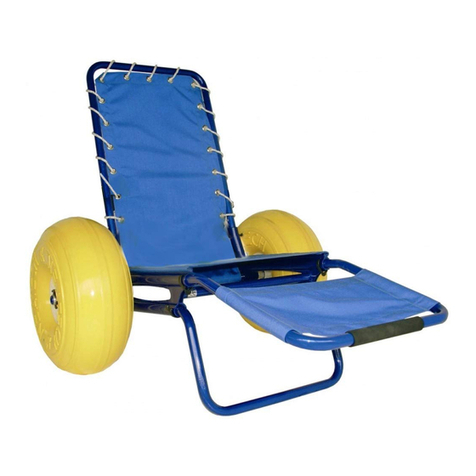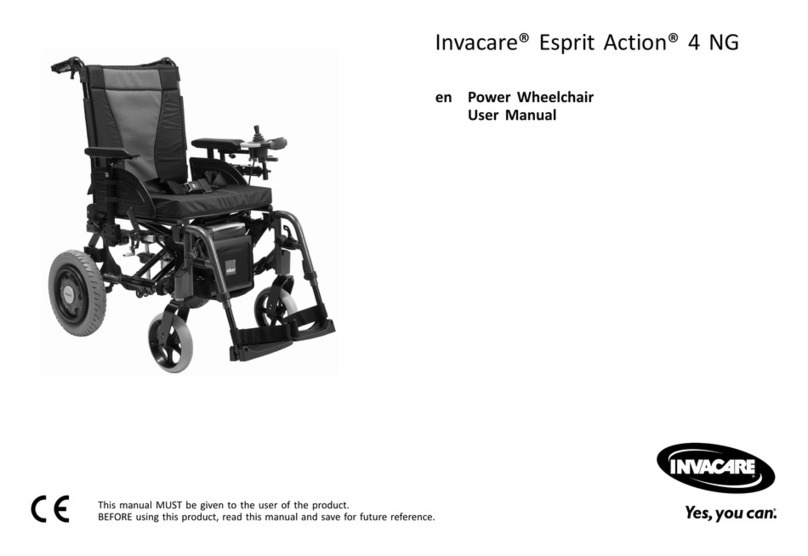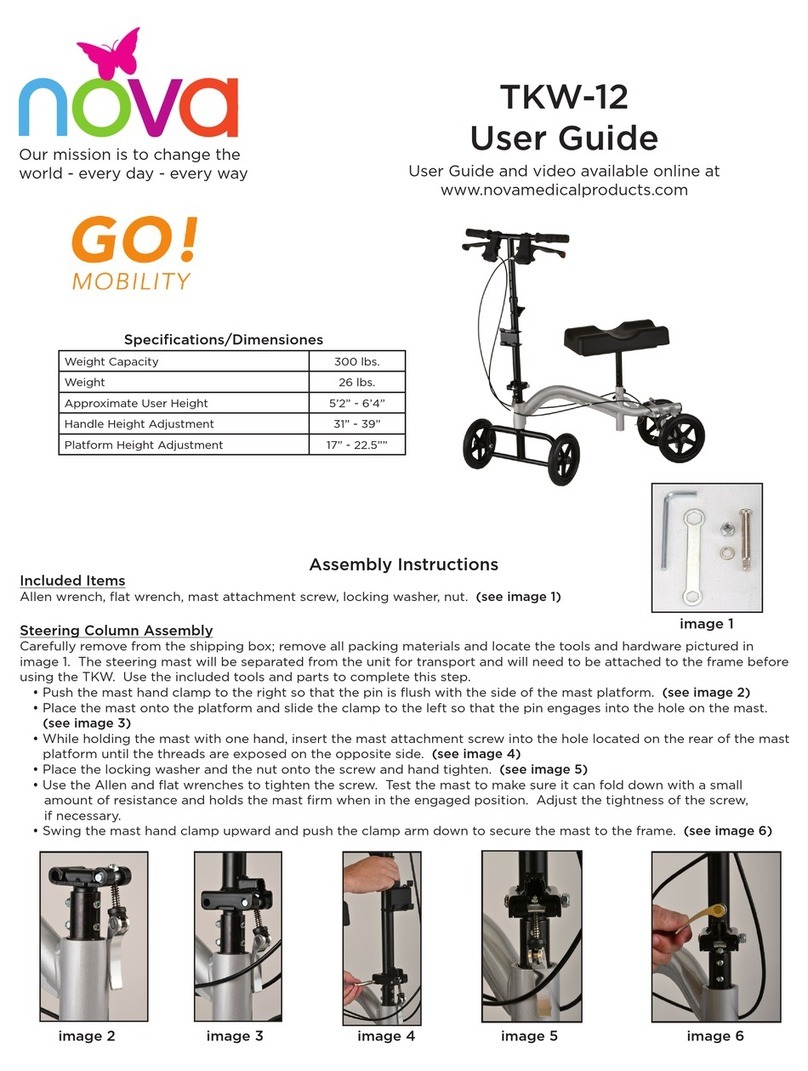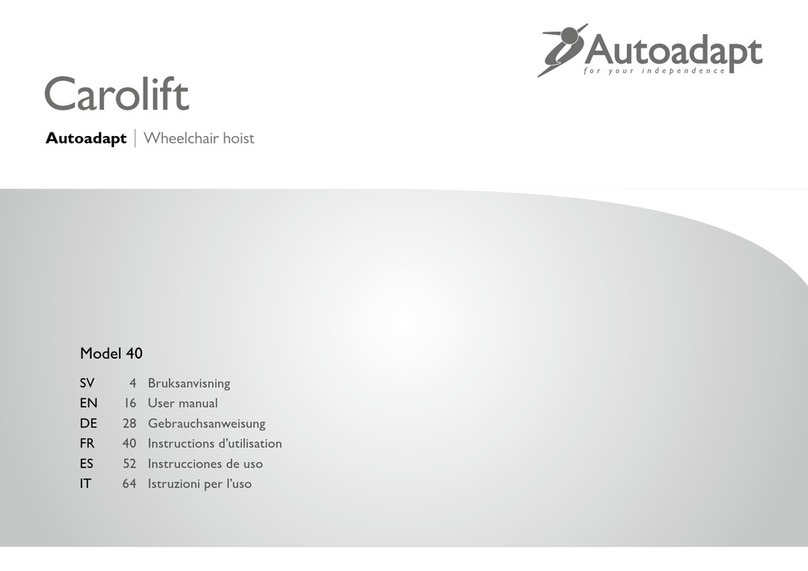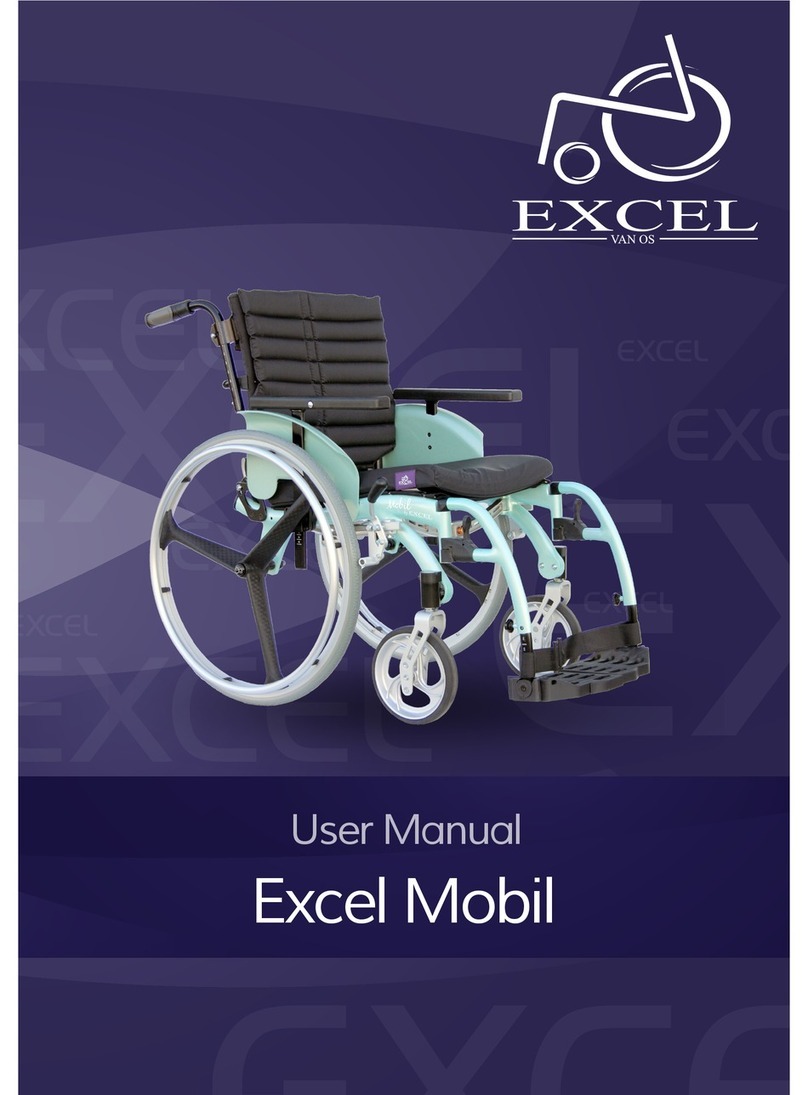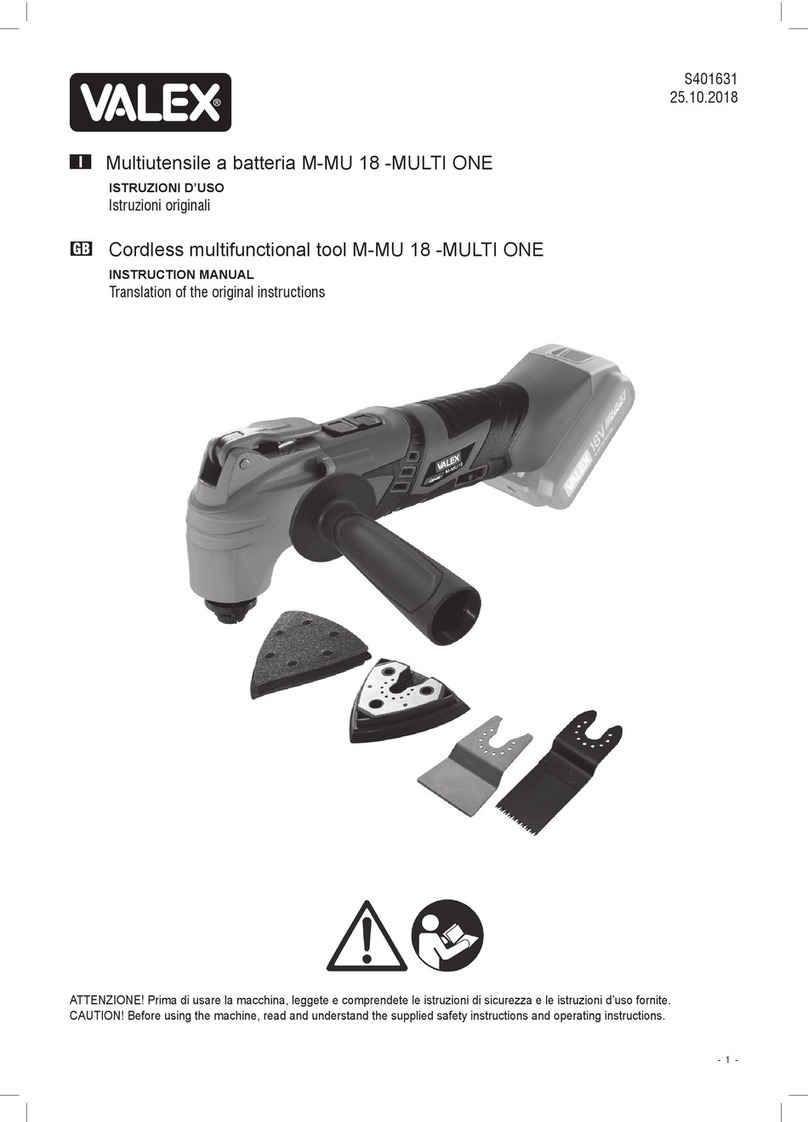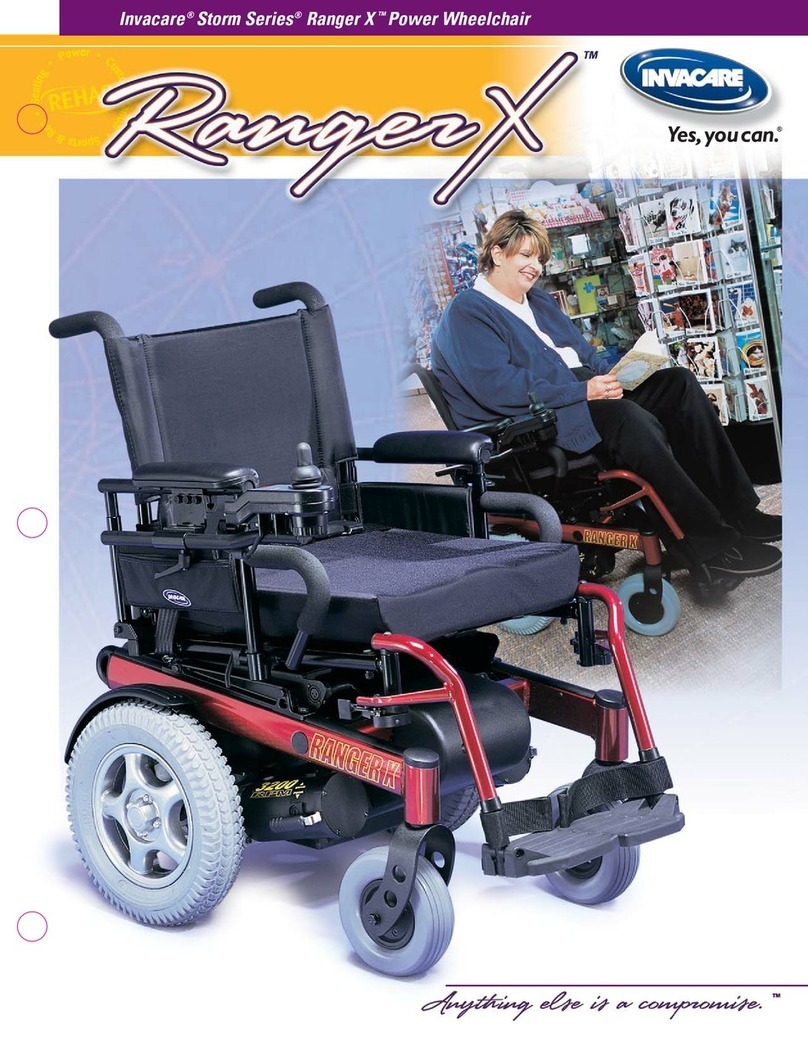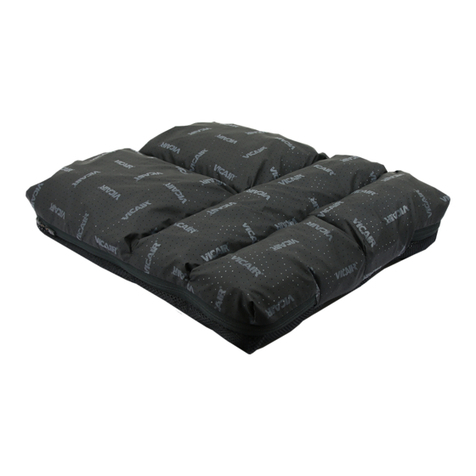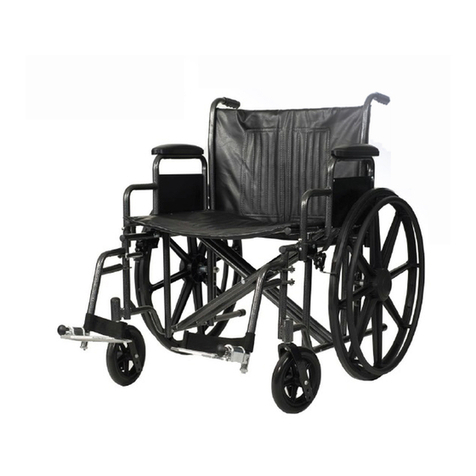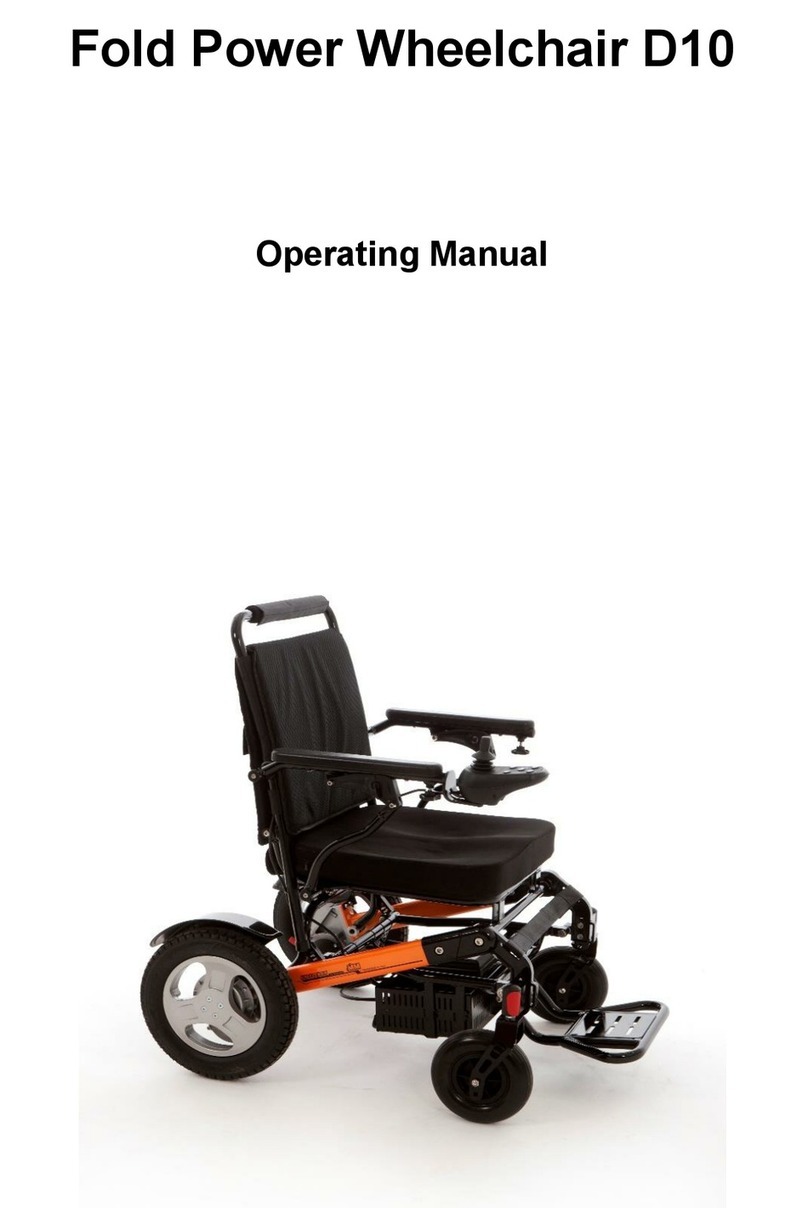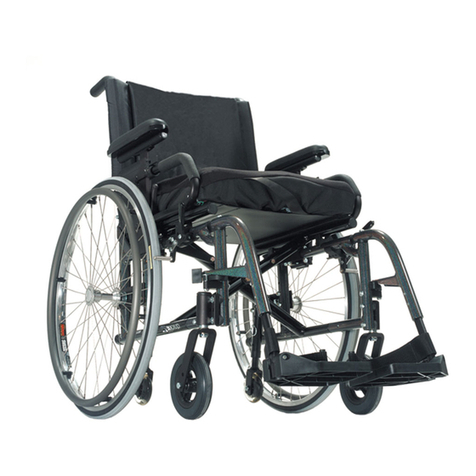Foldawheel PEGASUS II User manual

V2.0
User Manual
PEGASUS II

TABLE OF CONTENTS
PARTS INTRODUCTION
01
Title Page
Parts Introduction 01
1.0 Safety Tips 02 - 03
2.0 Set Up Upon Arrival 03
3.0 Adjustment 04 - 07
4.0 Operation 08
5.0 Storage 09
6.0 Control System 10
7.0 Maintenance 11
Contact Us 11
01. Backrest
02. Handle Controller
03. Rear Wheel
04. Handrim
05. Wheel Lock
06. Gas Spring
07. Quick-release Fork
08. Caster
09. Armrest
10. Safty Belt
11. Seatrest
12. Knee Belt
13. Heel Strap
14. Footrest
15. Battery
16. Anti-tilt
01
02
03
04
05
06
07
10
13
12
14
08
09
11
15
16

02
1.0 SAFETY TIPS
1-1-1. Standing up stresses your body in ways you may not be used to. Therefore
we recommend you consult your doctor or physical therapist before using the
standing wheelchair.
Check tyre pressure weekly (pneumatic tyres) , because it will aect the grip of the
wheel locks. Wheel locks are not designed to slow down the wheelchair when it is
moving. Wheel locks hold the wheelchair in place when it is at a complete stop.
Always set both wheel locks when entering or standing up or leaving the wheelchair.
Do not mount the quick release rear axles with the release button positioned inside
the frame. If the release button is inside the frame, the wheels will be released.
1-1-2. Before using the standing wheelchair, it is absolutely vital that the
knee support, safety belt and chest belt are xed correctly.
1-2. Wheel Locks
Making any unauthorized modications or using parts not supplied by technical
personnel, may change the wheelchair structure and create an unsafe condition,
thus voiding the warranty.
1-4. Modifications
1-3. Rear Wheel
1-3-1. Quick Release Axles
Check pneumatic tyres weekly for proper ination level, listed on tyre sidewall.
1-3-2. Pneumatic Tyres
Always practice with your Healthcare professional or attendant, before attempting to
negotiate curbs, Inclines or ramps alone.
1-3-3. Curbs, Inclines And Ramps
Warning : Doing a ”wheelie”(tilting the wheelchair backward to its balance point)
can be dangerous.
- Before using the stand up wheelchair, you should be familiar with
the operation and the function.
- Use only on standard household, hard and even ground. Not to be used on a
wet surface.
- In case of staircase, the stand up wheelchair must be carried by two persons.
- When getting on or off the stand up wheelchair , should not put the foot on the
footplate, to avoid danger.
1-1. Standing
Attention :
Warning : Maximum weight limit should not exceed 250 lb.(120 kg)
It is important for you to develop a safe, technique that is suitable to your abilities.

03
2.0 SET UP UPON ARRIVAL
Never lift the wheelchair by the armrests. These parts are raisable and
lifting the wheelchair by them may cause damage to the chair or injury to the user.
Stand up wheelchair does not advocate the use of power drive attachments on any
manual wheelchair. Use of a power drive attachment on a manual wheelchair alters
its intended use. Installation of a power drive attachment is considered an alteration
to the frame and voids the warranty.
1-5. Armrests
1-6. Power Drive Attachments
Armrests
-Standing wheelchair, heel strap &safety belt, chest belt
-Knee support and charger
-User manual and tool
-Options as ordered
2-1. The Original Package Contains The Following Components.
-Remove any transport straps or transport guards.
-Press Quick-release axles to attach rear wheel.(P1)
- Press Quick-release axles to attach front castor. (P1A~1B)
-Grasp the wheelchair at the backrest and pull backward. (P2)
- Press the Armrest forward (P3)
- Connect the DC power cord to power socket of battery.(P4)
2-2. Set-up The Standing Wheelchair :
P1
P2 P3 P4
P1A P1B
1.0 SAFETY TIPS

04
3.0 ADJUSTMENT
Should you require adjustments and alterations to the mechanism of the wheelchair,
or any maintenance work, please contact qualified technicians.
- Push the gas spring release lever and let the wheelchair frame rise over
the rear wheel.(P5)
- After loosening the left(right)screws on both sides, the seat depth can be
adjusted using the different holes at 1”distance.(P6~7)
- Retighten the left(right)screws on both sides.(P8)
Theheightofthefootrestisadjustableandshouldbealteredinlinewithyour
bodyproportionstoguaranteethebeststandingpositionpossible.Footrest
adjustmentshouldalsotakeintoaccountyourchoiceofseatcushion.(P9~11)
- Afterlooseningthescrews,theFootrestheightcanbeadjustedusingthe
differentholesat1.8cmdistance.
- Retightenthescrews.(nottootight)
3-1. Adjusting The Seat Depth
3-2. Adjusting The Footrest Height
P5 P6
P7 P8
P9 P11P10

05
3-2-1. Adjusting The Footrest Angle
3.0 ADJUSTMENT
Note:
Brakes adjustment are based upon the diameter and type of the wheels. After repairing a flat tyre
or in the event of wear of the pneumatic or solid tyre, you may need to adjust the brake(s).
- After releasing the screws the footplate angle can be adjusted using the different
hole at 3 range incline angle.(P12~14)
- Retighten the screws.
3-3. Adjusting The Backrest Height
3-4. Wheel Lock
- Remove the backrest pad and end cap.(P15~16)
- After opening both screws (left & right ),the backrest height can be
adjusted.(P17)
- Retighten the screws.
Themanualbrakesaredesignedtosecurethewheelchairduringlongstops.
Theyarenotintendedtoslowdownthewheelchairortobeusedassupport
duringatransfer.Theymustbeoperatedsimultaneously.Inordertobrake,
pushthehandle(A)downward(P18).Oncethebrakesareengaged,
thewheelchairshouldnotmoveatall.
Pullthehandleupwardtounlockthebrake(P19).
P12 P13 P14
P18 P19
A
P15 P16 P17
High Medium Low

06
3-5. The Knee Support and Belts
3.0 ADJUSTMENT
3-5-1. The Knee Support
3-5-2. The Heel Strap
The most important safety features of the stand-up wheelchairs are the knee
support, safety belt and chest belt. It is absolutely essential that these are correctly
in place before you attempt to stand up.
The knee support holds the knees in an extended posture and prevents you
slipping out of the wheelchair while standing.
Attach the two triangular clasp of the knee lock support
to the double-head screws on either side of the
wheelchair.(P20)
Center the knee support in front of each knee using
the Velcro fasteners, then pull it until it is sitting firmly in
place, just below (not right on) the knee cap and not
too tight.(P21)
P20
P21
Thepurposeoftheheelstrapistopreventthelegs
orfeetslippingbackwards.Itisfittedbehindthe
heelsorhigher.Bymakinguseofthevelcro
fasteningitispossibletoalterthelengthof
thestrapandthusensuretheidealpositionfor
thefeetonthefootrest.Idealpositioningofthefeet
isvitalinensuringagoodstandingposition.
P22

07
3.0 ADJUSTMENT
3-6. Adjusting The Armrest Height
P27 P28
-Releasetheleft(right)screwsuntiltheclampcanberemovedtosuitposition
(height7”~10”)(P27~28)
-Retightenthescrewsofclamp.
3-5-4. Adjusting The Chest Belt
-Makesurethatthechestbeltissecureonthevelcroatthebackofthebackrest.
-Thechestbeltistoholdtheupperbody(chest)inplace.
P24 P25 P26
3-5-3. The Safety Belt
- The safety belt holds the waist in place.
-Make sure that the safety belt is secured onto the
velcro fasten behind the backrest.
- Close the catch on the safety belt and pull it but not
too tight.
-To release the safety belt, simply press the red button
in the center of the catch.
- To slacken, hold the catch at a right angle to the belt
and pull.
P23

08
4-1. Standing
Note:
Before standing up, apply both brakes on the Pegasus II. Please beware of parts of
the wheelchair where one might conceivably trap or catch parts of the body when
standing up, in the space between the side panel / armrest and the seat as well as in
the pivot of the side panel / armrest. Be sure to protect yourself and accompanying
persons from possible injury.
The most important safety features of the stand-up wheelchairs are the knee support,
safety belt and chest belt. It is absolutely essential that these be correctly in place
before you attempt to stand up.
Standing up stresses your body in ways you may not be used to. For this reason,
please consult your doctor or physical therapist before using the standing
aid to make sure you do not suffer from any conditions (e.g. strong contractures
or osteoporosis) which make standing potentially harmful. The Pegasus II
may only be brought into the standing position on firm, level ground
(risk of tipping over).
P29
- You can control Up/Down movement using a
small controller at the tip of armrest (can be
either right or left side)(P29).
- User can stop in any position when going
Up/ down
4.0 OPERATION

09
5.0 STORAGE
5-1. Backrest Folding
5-2-1. Press the release button in the center of
the wheel, then pull off or re-mount the wheel
(P33).
Your Pegasus II is equipped with a folding backrest which allows you
to cut down significantly on the space required to store the wheelchair away.
Pull the chord and at the same time press the backrest lightly forward. You can
fold the backrest (P30~32)
5-2 The Quick-release Axles
The quick-release axles enable you to remove and re-mount the rear
wheel of your Pegasus II , thus reducing significantly the volume and
weight of the wheelchair. When removing a wheel, the wheelchair must be
unoccupied. The wheelchair should be supported in such a way that it neither
falls over nor rolls away after removing the wheel.
P30
P33
P31 P32
5-2-2 To remove and set back the castors together
with the front forks, press the quick-release
axle from underneath, then pull off the forks.
(P34)
P34

10
6-1. Battery and Control Box Connection
The main electrical control system is composed of the motor, Control box battery
and controller.
Connect the power cord of the control box to the battery.
6-2. Battery Charge
The buzzer for Battery Capacity and Controller
1. First connect the battery charge cord to the battery DC power socket,
make sure the cord is properly connected .
2. Connect the AC power cord of the charger to the AC socket. (100~240V)
3. The light of battery charger changes from yellow to green represent
the battery charge is complete.
6.0 CONTROL SYSTEM
Battery capacity
indictor color
Power condition
Green
Yellow
Red
* When the battery power is empty power, it will stop working.
Battery
power
indicator
color
Battery
Capacity
Controller
Sound of buzzer
Green
Full power
Switch ON
◎
Sound 1 times
Full power
Switch OFF
◎
(Not using over 30 min
)
Yellow
Half power
◎Switch ON
Short sound 1 times
Half power
◎Switch OFF
(
Not using over 30 min)
◎Control mode
◎
Switch can only Push
downward
(Safety mode)
Sound
continue when using
Red
Empty power
Shut down
◎
(
Must charge immediately)
N
ote:
If
the motor stops working, but the chair still in standing position, please use battery charger.
about 5 min
Attention :
1. Check the battery
capacity weekly.
2. New battery must charged
over 8 hours.
3. Charge your battery from the
battery charger provided by
manufacturer only.
Battery Capacity
Indicator
DC Power Socket
Charging Socket
Full Power
Half Power
Low Power
-
-
No light
Low power
Battery life.
(about 5 minutes)
. The chair can slowly sit down.Do not do it oftenly, It will reduce the

Wheelchair88 Ltd
wheelchair88.com
+60-3-3318 3133
Advanced Mobility Technology
@WheelChair88
7.0 MAINTENANCE
When cleaning your Pegasus II use a dry or slightly moistened
cloth to wipe the wheelchair down. For stubborn or oily stains, apply a mild
detergent to the cloth. Do not hose down your Pegasus II with water.
According to frequency of use, check tyre pressure between once a week and
once a month. If necessary, pump the tyres in line with manufacturer’s
recommendations.
Check the state of the tread on the tyres every one to six months. If a tyre is heavily
or unevenly worn, it should be replaced.
Every one to six months, check the brakes to ensure it’s still working well.
when applied the brakes, the wheels should stop turning completely.
If the brakes are ineffective, they should be tightened up.
According to frequency of use, lubricate the joints between once a week and once
a month.(P35~40)
P35 P36 P37
P38 P39 P40
Table of contents
Other Foldawheel Wheelchair manuals






